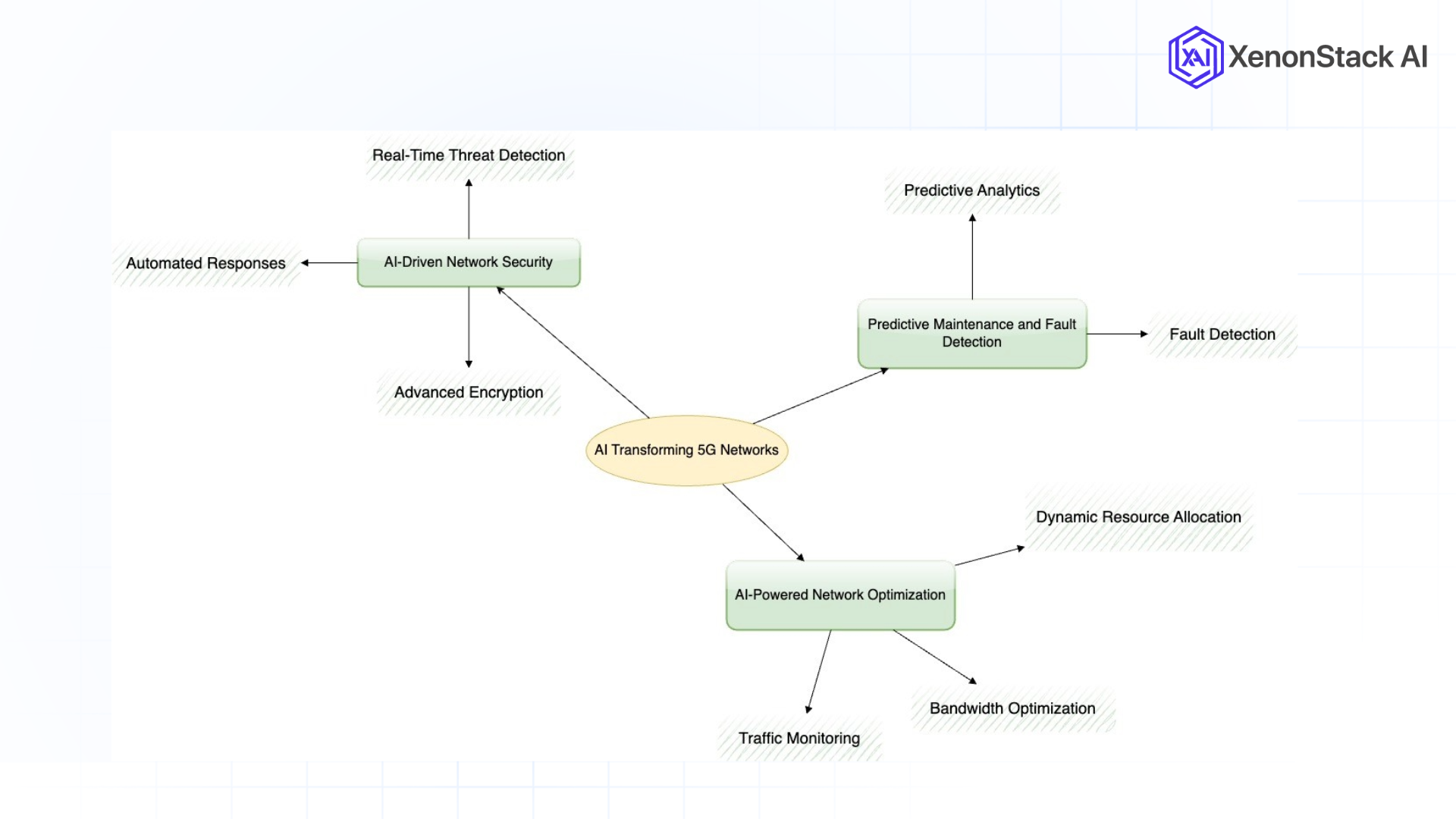The Role of Edge Computing in AI-Driven 5G Networks
Decentralization is crucial to edge computing because it can tackle latency issues towards real-time decision-making.
By processing data closer to the source, edge computing supports:
-
Faster data analysis.
-
Improved response times.
-
Enhanced scalability of AI applications in 5G networks.
Architecture of AI in 5G Networks
The architecture of AI-driven 5G networks consists of three key components:
-
Data Collection Layer: In this role, the platform collects data from IoT devices and sensors connected to the 5G network and other endpoints where users interact with the environment.
-
AI Processing Layer: Sited at the periphery of the cloud centre, this layer involves AI algorithms that analyse and process the data in innovative real-time.
-
Action Layer: In his article ‘How AI is Revolutionizing Networking,’ Richard believes that AI should be used to execute decisions like increasing bandwidth, traffic redirection, and others, based on the analysis done by artificial intelligence.
Below is an architecture diagram illustrating this workflow:
 Figure 2: Workflow diagram
Figure 2: Workflow diagram Explanation:
-
5G Network Infrastructure: This conveys the architecture's central interface and collects massive quantities of data from connected devices.
-
AI Engine: The node that receives and processes materials for their utilisation across different section tenancies.
-
Real-Time Traffic Analysis: AI also enhances network traffic flows to minimize congestion.
-
Fault Detection & Prediction: Contained within it are potential problem areas and recommendations for solutions.
-
Security Analysis: AI looks for network threats, guaranteeing its protection.
-
Dynamic Resource Allocation: Real-time monitoring's advantage is that it also helps to manage computer resources efficiently, especially bandwidth.
-
Due to the support of 5 G and Responsible AI, new-age applications include healthcare, autonomous vehicles, smart cities, and industrial IoT.
Real-World Applications of AI in 5G
Several industries are already leveraging the power of AI in 5G networks:
- Manufacturing (Industry 4.0)
-
Predictive maintenance of machinery.
-
Real-time coordination of AI-powered robots.
-
Real-time tracking in supply chain management.
- Smart Healthcare
-
Remote patient monitoring with wearable devices.
-
Telemedicine powered by low latency 5G connections.
-
Robotic surgeries are led by live artificial intelligence decision-making.
-
Smart Cities and Transportation
-
Intelligent traffic management systems.
-
Real-time monitoring of public infrastructure.
-
Autonomous vehicle navigation.
- Immersive Entertainment
-
It includes high-quality video streaming based on content delivery with the help of artificial intelligence.
-
Continuous, impactful VR/AR experiences due to 5G’s latency.
-
The relevance would also come from an advanced content recommendation system powered by AI.
Challenges in AI-Driven 5G Integration
Despite its potential, the integration of AI and 5G faces several challenges:
-
Data Privacy and Security: It is essential to accommodate the organization's data processing needs and users’ data privacy.
-
High Computational Demands: AI was found to demand high computational power to ensure it works correctly; it will consume more energy and require expensive hardware investment.
-
Legacy System Integration: Integrating AI into new infrastructure is relatively easier than integrating it into old infrastructures needed to establish 5G networks.
Future of AI in 5G Networks
-
More innovative networks: AI shall take 5G to the next level regarding operation and security.
-
Enhanced edge computing: The ability to make decisions closer to the data source created by edge computing will create new applications, including autonomous aerial vehicles and precision care.
-
The rise of 6G: Based on the advanced AI-empowered 5G, the subsequent level of networks appears to be even more beneficial.
The convergence of AI and 5G networks acts as a catalyst for the future of connectivity. By overcoming the difficulties and revealing the benefits of the combinational application of these technologies, industries can achieve unprecedented results in terms of reliability and efficiency. The transition to closed-loop AI for 5G networks has a long way to go. However, with such possibilities for further development of communication networks to transform the world’s connectivity, the journey is still long but exciting. AI is Enabling Smart Energy Consumption in Homes and Industries.
FAQs on AI in 5G Networks
-
What part does AI take in the 5G network?
AI applied in 5G networks optimizes duties, including traffic monitoring, existing network maintenance, resource optimisation, and others. It also enhances security through enhanced threat detection.
-
How does AI enhance the performance of a 5G network?
Network traffic is also continuously analysed in real-time to detect possible faults, and resource usage is always checked. This reduces the time that elapses before a user can access the content, ensures optimal bandwidth resource usage, and offers a compelling user interface.
-
What are some applications of artificial intelligence in 5G networks?
Key use cases include:
-
Competent healthcare (real-time patient monitoring).
-
Autonomous vehicles (enhanced vehicle-to-everything communication).
-
Smart cities (traffic and energy management).
-
Some examples of Industrial IoT (predictive maintenance of connected devices).
-
How does AI seek to facilitate the predictive maintenance of 5G networks?
AI can detect contract issues in the network to identify signs of failure. It anticipates in which timeframe and location problems can occur and forestalls them, leading to a lack of downtime.
.webp?width=1921&height=622&name=usecase-banner%20(1).webp)





